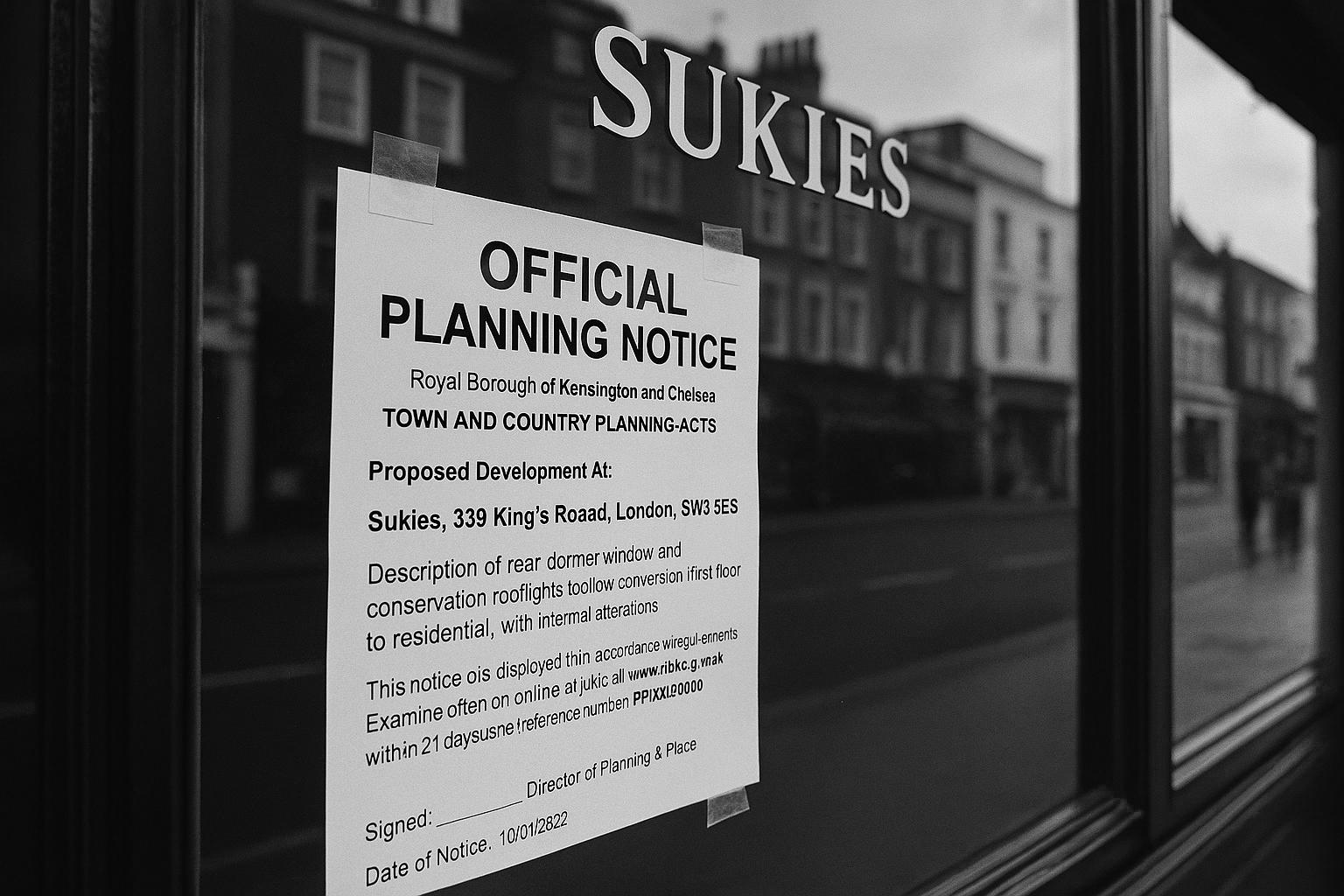Sukies, the last independent shoe shop on King’s Road, says it may be forced to close after Raffles Chelsea submitted plans to deepen and extend the basement beneath 285–287 King’s Road. According to the Evening Standard, the club’s proposals would lower the existing partial single‑storey basements at the front and extend the footprint to the rear to create a new staircase, bar, toilets and a lounge — works that neighbours fear will change the character of the street. Around 35 local residents and businesses have lodged objections citing noise, increased antisocial behaviour and crime, although the council has responded that the changes would not amount to an “intensification” of use because overall capacity is intended to remain unchanged, and that construction noise on its own would not justify refusing the application; the planning application was reported as due to be considered on 12 August.
The development is formally recorded on the Public Notice Portal as planning application PP/25/00602, a public notification intended to alert local people and allow representations to be submitted to the council’s planning register. The public notice confirms the basic scope of the works and sets out how neighbours can locate the full planning documentation if they wish to examine drawings, environmental assessments or condition proposals. That statutory notification is a routine part of the planning process but it is the primary gateway through which concerns about impacts such as vibration, access and loss of storage are registered.
The debate around the works is running on a parallel licensing track. Meeting papers summarised by OpenCouncil Network show that Raffles Chelsea has also sought a new premises licence for the same premises; residents told the licensing sub‑committee they fear the proposals would effectively double usable floorspace and increase late‑night disturbance. The licensing pack compared current and proposed licensable activities and recorded a string of local representations alleging heightened noise and antisocial behaviour, illustrating how licensing and planning objections can overlap and be raised through separate regulatory routes.
Kensington and Chelsea’s regulatory approach places particular weight on managing construction impacts rather than refusing applications solely because they will be disruptive. The council’s Code of Construction Practice, revised in April 2019, requires developers to submit a Site Construction Management Plan, categorise sites by impact, pay monitoring fees where necessary and adopt “best practicable means” to limit noise, vibration and dust. The guidance sets permitted working hours, restricts high‑impact activities to specified times, and points to powers under S60/S61 of the Control of Pollution Act for higher‑impact sites; it also explains that complaints will be investigated by the Noise and Nuisance team. In short, the borough’s published guidance emphasises mitigation, monitoring and neighbour liaison as the primary means of controlling disturbance.
Campaigners on the ground, however, say mitigation is not enough. The Save Kings Road group has compiled documents and templates for objections, arguing that cumulative basement excavations along the street create lasting harm — from loss of retail storage to increased traffic, vibration and pressure on local businesses. The campaign highlights Sukies as an example of a small, specialist retailer that could lose vital storage or face disruption that undermines its ability to trade, and it has been actively encouraging neighbours to use the planning portal to register their concerns.
The dispute crystallises a familiar urban dilemma: nightlife operators and property owners seeking to refurbish and enhance facilities, and small independents and residents resisting changes they fear will erode local character. Raffles Chelsea maintains the works would not raise capacity and says the refurbished basement simply modernises existing facilities; neighbours and small traders remain sceptical and point to a history of late‑night issues in parts of the borough. The council’s procedures provide a framework of conditions, consents and enforcement to limit the worst construction impacts, but those measures are not a guarantee against longer‑term change — which is why local mobilisation and formal objections can carry weight in subsequent decisions.
With the planning application public and the licensing process having attracted representations, the next procedural steps will be closely watched by both sides. Residents can view the planning documents on the council’s planning portal and submit representations before the council determines the application. Whether mitigation measures and licence conditions will satisfy neighbours — or whether the concerns of a small shop at the end of King’s Road will be borne out in loss of trade — remains to be decided when the authorities consider the applications.
📌 Reference Map:
##Reference Map:
- Paragraph 1 – [1], [2]
- Paragraph 2 – [3], [1]
- Paragraph 3 – [6], [2]
- Paragraph 4 – [4], [5]
- Paragraph 5 – [7], [2]
- Paragraph 6 – [4], [5], [7], [1]
- Paragraph 7 – [1], [3], [7]
Source: Noah Wire Services
